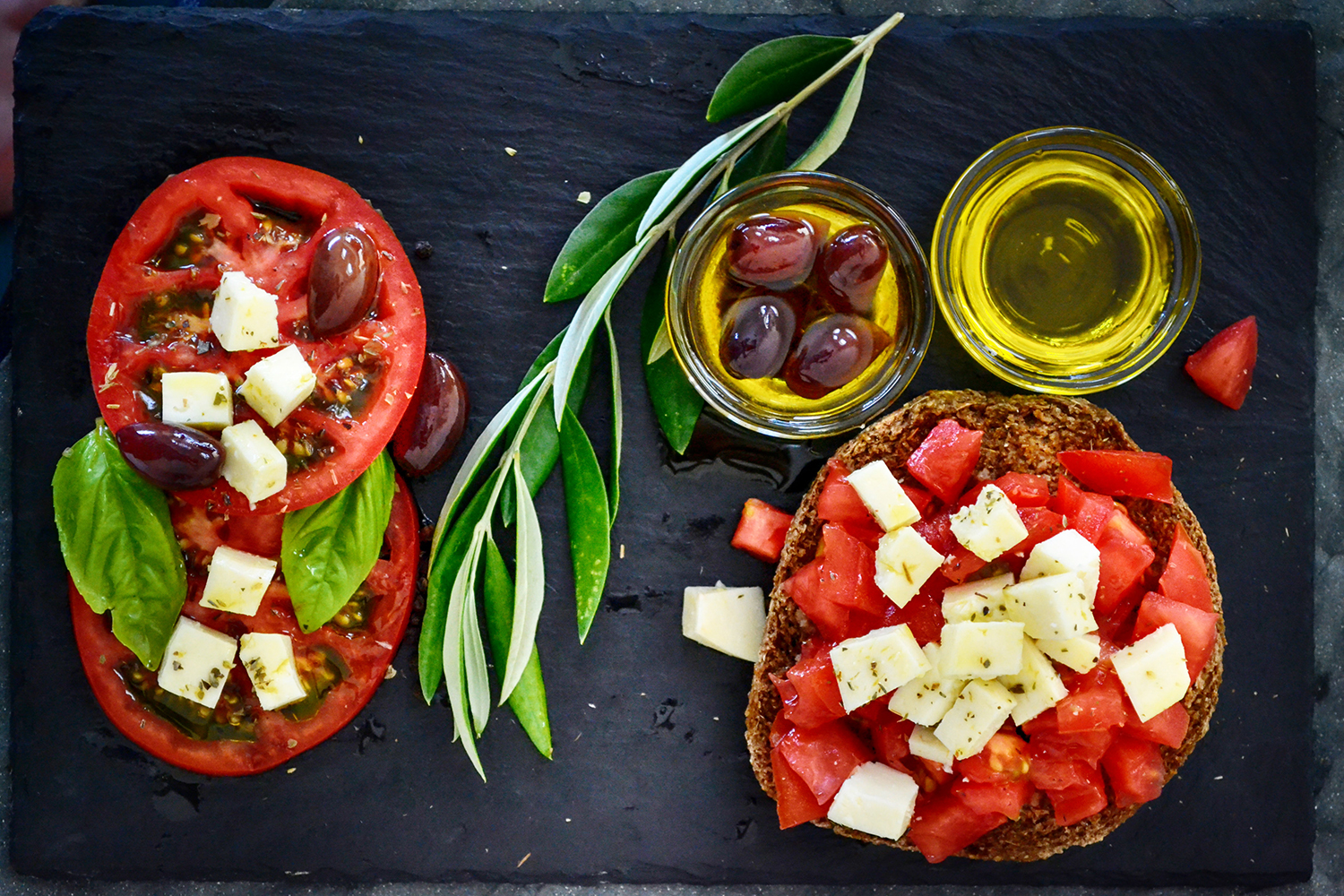Mediterranean Diet to Reduce Heart Disease

I’m sure you’ve heard of the Mediterranean Diet and it’s link to heart health. The Mediterranean Diet emphasizes fruits, vegetables, whole grains, fish, and monounsaturated fats (olive oil).
Those that follow a Mediterranean Diet have a reduced there risk of developing heart disease and dying from a heart attack. Even those that have survived a heart attack and lived to adopt the Mediterranean Diet significantly reduced their risk of a second heart attack and other complications.
In an interesting twist, the native Mediterranean population has gradually adopted a more Western diet leading to negative results. The Mediterranean area has seen an income rise that’s resulted in extra dollars being spent on meat and saturated fat food sources. Over the past 4 decades the average calorie intake in the Mediterranean countries has increased ~30%. So, the once healthy Mediterranean countries are now seeing the weight epidemics the US is familiar with – 75% of the population overweight or obese in Greece, with over half of the population in Italy, Spain, and Portugal following suit. These countries are now supporting the “Mediterranean Diet” as a part of their cultural heritage they can not let die.
Here’s a quick breakdown of the characteristics common to a Mediterranean Diet:
- High intake of fruits and vegetables
- Select whole grains
- Consume healthy fats (canola and olive oil)
- Eat nuts in moderation
- Low red wine consumption
- Limit eggs to less than 4 times per week
- Consume little red meat
- Eat fish regularly
All the best,
Lisa Nelson, RD, LN
eNutritionServices
Reduce Heart Disease with Glucomannan
Have you heard of glucomannan? Glucomannan is a type of soluble fiber. Research has shown that for every 1-2 grams of daily soluble fiber intake, LDL (bad) cholesterol is lowered 1%. Check out this post from Janie Ellington to learn more about glucomannan and how it reduces heart disease risk:
Benefits of Glucomannan Against Risk Factors for Heart Disease
All the best,
Lisa Nelson, RD
eNutritionServices
Make Your Halloween Healthier

Halloween is just around the corner, which means trick-or-treating, and I stress the “treating”. Eliminating candy completely at Halloween is not a feasible option and why spoil a fun holiday the whole family should enjoy? However, by taking a few simple steps you can limit the amount of candy in your home and maintain a balance between holiday treats and your health goals.
- Are you throwing or attending a Halloween party? Limit the cookies/candy and aim for some traditional fall goodies, such as caramel covered apples, pumpkin dip and pumpkin bars, which are tasty treats that offer some good nutrition too. If you are the party host, plan some party activities that get guests up and moving – Monster Mash dance contest or a scarecrow building contest – to work off some of the holiday goodies while having a ghoulish good time.
- Limit the number of homes you take your children to for trick-or-treating. The fewer homes you visit, the less candy you take home.
- “Donate” excess candy to the office or your child’s teacher. You and/or your spouse can place a candy dish at your office to share with co-workers and your children can load up a bag to give to teachers for school treats throughout the year.
- Purchase only what you think you’ll need to hand out to trick-or-treaters. Estimate how many little devils and goblins came knocking on your door previous years and purchase just enough candy to cover your expected trick-or-treaters. This will limit the leftover candy you will be tempted to consume after the big night.
- Portion control is key. Watch how much you eat at a time. If you have a sweet tooth, keep the candy out of sight and limit yourself to one or two pieces each day.
Halloween comes around once a year and for those dealing with health issues, such as heart disease or excess weight; this may be a stressful time trying to balance a healthy diet with the influx of candy. By following the above tips and making good decisions you can enjoy this time of year and some sweets, too.
Happy Halloween!
Lisa Nelson RD
Your Checklist to Lower Cholesterol
Here’s a checklist of the top 8 things you must do if you want to successfully lower your cholesterol and keep it low.
Know your numbers
Have you had a lipid profile? Do you understand the numbers? If you are going to successfully lower cholesterol you need to know your numbers and what they mean. The most effective way to raise HDL is not necessarily the best way to lower LDL.
Evaluate your lifestyle
There are risk factors for high cholesterol that you can not control, such as age, gender, and family history, but there are factors you can control. For example, you can reduce risk by not smoking, increasing your activity, and losing extra weight.
Balance your fats
Reduce unhealthy saturated fats in your diet and replace them with heart healthy unsaturated fats. Total fat intake should be 30% or less of your total daily calories. Out of this 30%, saturated fat should be limited to 7%.
Be active
Physical activity lowers triglycerides and raises HDL (good) cholesterol. Shoot for 30 minutes 5 or more days a week. If you are not currently active, check with your MD before beginning an activity program.
Eliminate trans fats
You need to be food label savvy and watch out for trans fats. Trans fats raise LDL (bad) cholesterol, lower HDL (good) cholesterol, and raise triglycerides. Limit trans fats to 1% or less of your daily caloric intake.
Understand triglycerides
Triglycerides are impacted the most by your simple sugar and alcohol intake. If you are struggling with high triglycerides, you need to use a different strategy to get your cholesterol under control.
Increase dietary fiber
A high fiber diet is necessary for heart health. You need 25-35 grams of dietary fiber daily, especially soluble fiber. For every 1-2 grams of daily soluble fiber intake, LDL (bad) cholesterol is lowered 1%.
Add omega 3 fatty acids
For heart health and lower cholesterol, you want to improve the ratio of omega 3 to omega 6 fatty acids. Omega 3 fatty acids are involved in the regulation of heart rate, blood pressure, and blood clotting.
Receive a step by step plan to promote heart health with a Mini Diet Makeover. As a special New Year’s bonus you’ll recieve a complimentary copy of the Calorie Counter for Dummies. Learn more here – https://www.lisanelsonrd.com/minidietmakeover.html
All the best,
Lisa Nelson RD
How to Lower Cholesterol in 8 Simple Steps
Vytorin to lower cholesterol
A reader from The Heart of Health is treating high cholesterol with Vytorin. The medication Vytorin is a combination of the statin drug Zocor and the cholesterol lowering drug Zetia. The two drugs differ in that statins function mainly in the liver to reduce production of cholesterol, while Zetia works in the digestive tract to block the absorption of cholesterol from food.
Vytorin is in the press right now, because of a possible link to increased cancer risk. Studies including 20,000 patients compared cancer in those treated with Vytorin (313) to those taking a Zocor/statin drug (326). Actual cancer deaths were greater in those taking Vytorin (97) versus Zocor (72). From my perspective, that is not a significant difference; however, there are experts that agree with me and experts that disagree.
Anyway, The Heart of Health reader requested my thoughts.
First, absolutely discuss with your MD the best treatment for you. I would discuss the possibility of a statin lowering drug with proven effectiveness/safety as an alternative until the controversy regarding Vytorin is settled. Also, there is debate surrounding the effectiveness of Zetia at preventing heart disease.
Of course, I do not know your personal situation and if you have tried a statin with poor results in the past.
Anytime you have to take a medication, there is the risk of side effects. Many times it’s simply a matter of weighing the pros and cons and deciding how much risk you’re willing to take.
Of course, I promote making lifestyle and diet changes to lower cholesterol to eliminate the need for medications or at least reduce the amount of medication needed to treat your condition.
If you are not a current subscriber to The Heart of Health, you’ll receive a subscriber exclusive report: “Stop Wasting Money – Take Control of Your Health” and regular heart health and weight loss tips once you sign-up.
All the best,
Lisa Nelson, RD, LN
eNutritionServices
Brown rice – New whole grain health claim.
I’ve always recommended clients make a switch from white rice to brown rice as a way to boost dietary fiber intake. A diet high in dietary fiber (ideally 25-35 grams/day) is linked with reduced heart disease risk by lowering LDL and total cholesterol levels.
The FDA just approved a new ruling that will allow brown rice to use a health claim on its label. So, when you’re shopping for groceries, be on the look out for the new whole-grain logo added to the brown rice packaging and don’t forget to reach for the brown rice over the white! A 1/2 cup of cooked brown rice contains two grams of fiber.
Brown rice takes extra time to prepare (~45 minutes). I checked out the nutrition label on brown “minute” rice recently and it’s another option, still providing 2 grams of dietary fiber per 1/2 cup serving. Best of all, only takes ~10 minutes to prepare. Haven’t tried it yet, so can’t vouch for its flavor, but I have added it to my shopping list.
All the best,
Lisa Nelson, RD, LN
The Heart of Health



